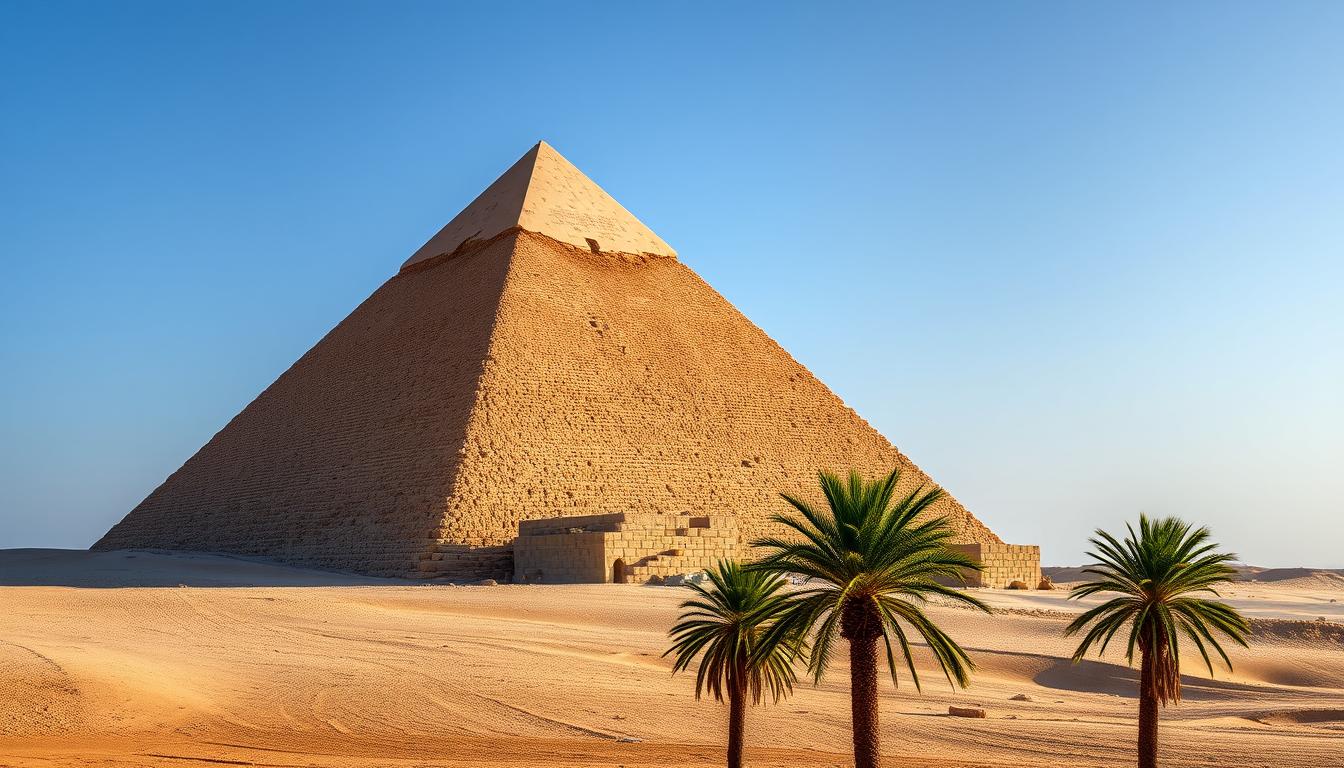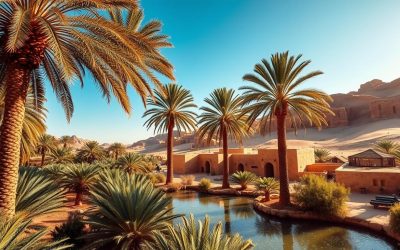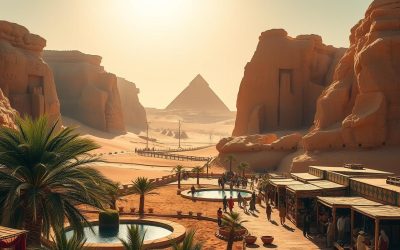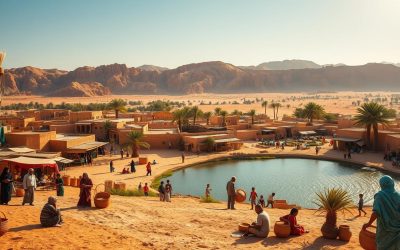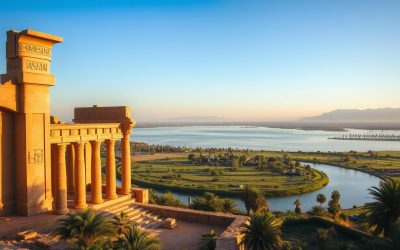Have you ever wondered what it’s like to walk through history? Imagine standing before the world’s oldest pyramid, surrounded by stories of ancient civilizations. This is the magic you’ll experience in this incredible location.
This site is more than just a collection of ruins. It’s a gateway to the past, offering a unique trip into the heart of ancient culture. From towering structures to hidden treasures, every corner holds a piece of history waiting to be discovered.
Whether you’re a history enthusiast or a curious traveler, this destination promises an unforgettable adventure. Ready to explore? Let’s dive into what makes this place so special.
Key Takeaways
- Discover the world’s oldest pyramid and its historical significance.
- Explore a site filled with ancient relics and hidden treasures.
- Experience a unique blend of history and modern travel tips.
- Learn about the architectural marvels that dominate the landscape.
- Plan an unforgettable journey into the heart of ancient culture.
Introduction: Discovering Saqqara
Step into a world where ancient stories come alive. This historic site, located just a short drive from Cairo, is one of the oldest necropolises in the world. It’s a place where the past feels tangible, and every corner holds a piece of history waiting to be explored.
Setting the Scene
Nestled near the bustling capital of Egypt, this area offers a stark contrast to modern life. Here, you’ll find the Step Pyramid, a marvel of ancient engineering that dates back over 4,600 years. It’s a testament to the ingenuity of early civilizations and a must-see for anyone interested in history.
Why You Should Visit
This destination is more than just a collection of ruins. It’s a journey through time, where you can walk among structures that have stood for millennia. Whether you’re drawn to the grandeur of the pyramids or the intricate details of ancient tombs, there’s something here for everyone.
- Experience the awe-inspiring Step Pyramid, the oldest stone pyramid in the world.
- Explore hidden tombs and mastabas that reveal the lives of ancient Egyptians.
- Enjoy a unique blend of history and modern travel convenience.
From its connection to Cairo to its role as a gateway to the past, this site promises an unforgettable adventure. Ready to dive deeper? Let’s uncover the stories that make this place so extraordinary.
Unearthing the History of Saqqara
What if you could witness the birth of monumental architecture? This historic site is home to the Step Pyramid of Djoser, the world’s first pyramid. Built over 4,600 years ago, it marked a turning point in ancient engineering and design.
The pyramid djoser was not just a tomb but a symbol of innovation. Its architect, Imhotep, transformed the traditional mastaba design into a towering structure. This shift laid the foundation for all future pyramids.
Before the pyramid djoser, tombs were simple, flat-roofed structures called mastabas. These early designs evolved into the grand pyramids we know today. The Step Pyramid was a bold experiment that changed history.
Djoser, the pharaoh behind this marvel, sought to create a lasting legacy. His pyramid complex included courtyards, temples, and hidden chambers. It was a place of both burial and worship.
Another key figure in this site’s history is Mereruka. His tomb, filled with intricate carvings, offers a glimpse into ancient life. Mereruka’s influence extended beyond his time, shaping the site’s cultural significance.
Here’s a quick overview of the key elements:
| Element | Description |
|---|---|
| Step Pyramid of Djoser | The world’s first pyramid, built by Imhotep. |
| Mastaba Tombs | Early flat-roofed tombs that evolved into pyramids. |
| Mereruka’s Tomb | A richly decorated tomb showcasing ancient artistry. |
This site is more than a collection of ruins. It’s a testament to human ingenuity and the enduring legacy of ancient civilizations. From the pyramid djoser to the mastaba tombs, every stone tells a story.
Saqqara, Egypt: Best Things to Do – Top Picks
Ever wondered what secrets lie beneath the sands of time? This historic site is a treasure trove of ancient tombs and chambers, each holding stories of a civilization long past. Exploring these structures offers a unique glimpse into the lives and beliefs of those who lived thousands of years ago.
One of the highlights is the intricate murals found within the tombs. These detailed artworks depict scenes of daily life, religious rituals, and the journey to the afterlife. Every stroke of paint tells a story, making each visit a journey through history.
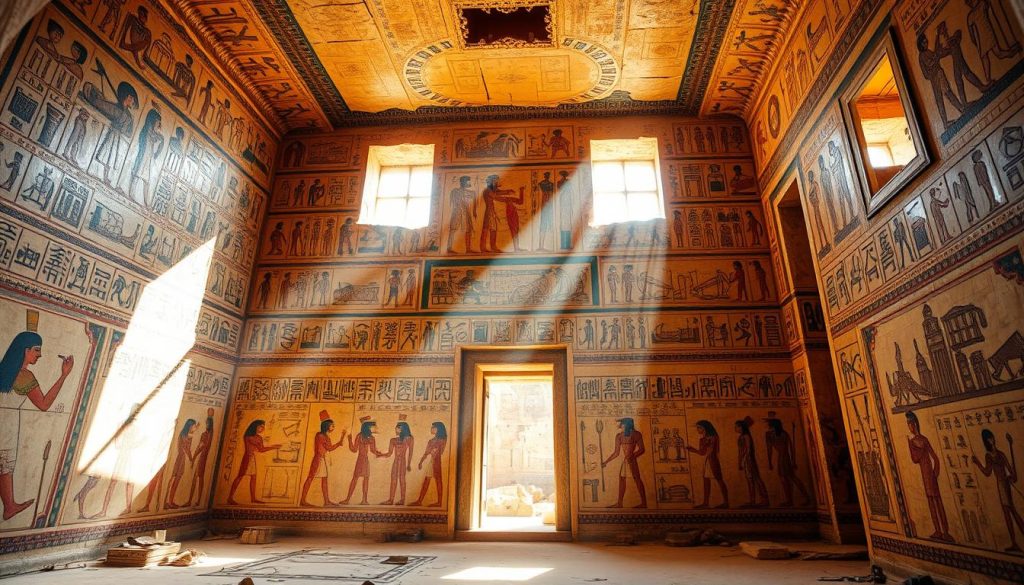
The chambers within these tombs are equally fascinating. Designed with precision, they served as both burial places and spaces for ceremonial practices. The layout of each chamber reflects the beliefs and customs of the time, offering valuable insights into ancient culture.
Here’s a quick guide to what you’ll discover:
| Feature | Description |
|---|---|
| Tombs | Richly decorated with murals and hieroglyphs. |
| Chambers | Intricately designed for burial and ceremonies. |
| Murals | Depicting daily life, rituals, and the afterlife. |
Exploring this site is more than just a visit—it’s an opportunity to connect with the past. Each tomb and chamber reveals a piece of history, waiting for you to uncover its secrets. Whether you’re a history buff or a curious traveler, this experience is unforgettable.
Exploring the Stepped Pyramid of Djoser
Imagine standing before a structure that changed the course of architectural history. The Stepped Pyramid of Djoser, built over 4,600 years ago, is the world’s first major stone monument. Designed by the brilliant architect Imhotep, it set the standard for future pyramids across the region.
Architectural Marvels
The pyramid’s design is a masterpiece of innovation. Imhotep stacked six mastabas, or flat-roofed tombs, to create its iconic stepped appearance. This bold experiment marked a shift from traditional burial practices to monumental architecture.
At 62 meters tall, the pyramid dominates the landscape. Its complex includes courtyards, temples, and hidden chambers, showcasing the ingenuity of ancient builders. This structure not only served as a tomb but also as a place of worship and ceremony.
Historic Significance
The Stepped Pyramid is deeply connected to the ancient city of Memphis, once the capital of early dynasties. It reflects the cultural and religious beliefs of its time, offering insights into the lives of those who built it.
This pyramid influenced the construction of later structures, including those in Giza. Its design paved the way for the grand pyramids we know today, making it a cornerstone of architectural history.
- Discover the world’s first stone monument, a marvel of ancient engineering.
- Learn how its design influenced future pyramids across the region.
- Explore its connection to Memphis and the early dynasties.
From its stacked mastabas to its towering height, the Stepped Pyramid of Djoser is a testament to human creativity and ambition. It’s a must-see for anyone fascinated by the roots of monumental architecture.
Marveling at Ancient Tombs and Mastabas
What if you could step into a world where every wall tells a story? The tombs and mastabas scattered across this historic site are a testament to the artistry and ingenuity of ancient civilizations. Each structure offers a unique glimpse into the lives, beliefs, and customs of those who lived thousands of years ago.
One of the most remarkable tombs is that of Mereruka. Its walls are adorned with vivid scenes depicting daily life, religious rituals, and the journey to the afterlife. These intricate carvings and paintings are not just decorations—they are windows into a bygone era.
Tomb of Mereruka and Other Notable Structures
The Tomb of Mereruka stands out for its detailed craftsmanship. Every corner of this tomb is filled with stunning artwork, from hunting scenes to depictions of family life. It’s a masterpiece that has survived millennia, offering visitors a chance to connect with the past.
Other tombs in the area are equally fascinating. Each one tells a different story, with unique features that reflect the status and personality of its occupant. Exploring these structures is like walking through a gallery of ancient art.
- Discover the richly decorated Tomb of Mereruka, a highlight of the site.
- Marvel at the intricate scenes that reveal insights into ancient life.
- Learn about the architectural details that make each tomb unique.
To make the most of your visit, consider arranging a taxi for convenient access to the site. This tip ensures you can explore at your own pace without worrying about transportation. Don’t forget to tip your driver for their service—it’s a small gesture that goes a long way.
From the artistry of the tombs to the practical tips for your visit, this site offers an unforgettable experience. Every step you take is a journey through history, where the past comes alive in the most extraordinary ways.
The Mysterious Serapeum Experience
Have you ever imagined uncovering secrets buried deep beneath the earth? The Serapeum is one of the most enigmatic sites you’ll encounter. This underground complex is a testament to the ingenuity and spiritual depth of ancient civilizations.
At the heart of the Serapeum are the burial chambers dedicated to the sacred Apis bull. These massive stone sarcophagi were designed to honor the bull, considered a divine symbol in ancient times. The rituals surrounding its burial were elaborate, reflecting the deep spiritual connection of the people.
Sacred Apis Bull Burial Chambers
The chambers themselves are a marvel of engineering. Carved from solid stone, they house the remains of the Apis bulls, each one a symbol of strength and divinity. The precision of the craftsmanship is awe-inspiring, showcasing the skills of ancient builders.
This site is also closely linked to Imhotep, the brilliant architect behind the Step Pyramid. His influence is evident in the design and layout of the Serapeum, making it a key part of his legacy. The connection to Imhotep adds another layer of intrigue to this already fascinating place.
Here’s a quick overview of what you’ll discover:
| Feature | Description |
|---|---|
| Burial Chambers | Massive stone sarcophagi for the sacred Apis bull. |
| Rituals | Elaborate ceremonies honoring the divine bull. |
| Design | Precision craftsmanship influenced by Imhotep. |
Exploring the Serapeum is like stepping into a hidden world of mystery and symbolism. Every corner holds a piece of history, waiting for you to uncover its secrets. Whether you’re drawn to the spiritual significance or the architectural brilliance, this site offers an unforgettable experience.
Navigating Your Saqqara Day Trip from Cairo
Planning a day trip to explore ancient wonders? Here’s how to make it seamless. Located just 30 kilometers south of Cairo, this historic place is a must-visit for history enthusiasts and curious travelers alike. With its sprawling layout and numerous attractions, proper planning ensures you don’t miss a thing.
Travel Routes and Transportation Tips
Reaching this ancient complex is straightforward. The most convenient options are by car or taxi. Renting a car gives you flexibility, while hiring a taxi offers comfort and local expertise. Both options allow you to explore at your own pace.
Once you arrive, navigating the site is easy. The complex is well-organized, with clear pathways leading to key attractions like the Step Pyramid and the burial chamber of the Apis bull. A map or guidebook can help you plan your route efficiently.
Here’s a quick guide to transportation options:
| Option | Details |
|---|---|
| Car Rental | Flexible and ideal for independent travelers. |
| Taxi | Comfortable and often includes local insights. |
| Guided Tours | Includes transportation and expert commentary. |
For a stress-free experience, consider starting early to avoid crowds and heat. This place is vast, so allocate enough time to explore its highlights, including the Step Pyramid and the fascinating burial chamber of the Serapeum.
With these tips, your day trip will be both enjoyable and memorable. Whether you’re marveling at ancient architecture or uncovering hidden treasures, this complex promises an unforgettable adventure.
Buying Tickets and Understanding Saqqara Fees
Planning your visit to this historic site starts with understanding ticketing options. The entrance process can be a bit complex, but with the right information, you can make the most of your experience. Whether you choose an all-inclusive ticket or separate ones for individual attractions, knowing the details will save you time and hassle.
Inclusive Versus Separate Tickets
One of the first decisions you’ll face is whether to purchase an all-inclusive ticket or buy separate ones. The all-inclusive option grants access to all major attractions, including the Step Pyramid, the Serapeum, and the statue exhibits. This is ideal if you plan to explore everything in one visit.
On the other hand, separate tickets allow you to focus on specific areas. This can be a good choice if you’re short on time or only interested in certain sites. Keep in mind that some attractions, like the Serapeum, require additional fees even with an all-inclusive ticket.
Here’s a quick comparison to help you decide:
- All-Inclusive Ticket: Best for full-day visits and those who want to see everything.
- Separate Tickets: Ideal for shorter visits or targeted exploration.
Ticket counters are located near the main entrance, and it’s a good idea to arrive early to avoid long lines. Once inside, the site’s layout includes several passages that connect the main attractions. Planning your route in advance can help you navigate efficiently.
Here are a few tips to make your visit smoother:
- Check the official website for updated ticket prices and options.
- Bring cash, as some ticket counters may not accept cards.
- Consider hiring a guide for insights into the site’s history and layout.
Understanding the ticketing system and the site’s layout will ensure a seamless experience. Whether you’re marveling at the ancient statues or exploring the hidden passages, proper planning will make your visit unforgettable.
Saqqara Opening Hours and Best Visit Times
Want to make the most of your visit to this historic site? Knowing the opening hours and the best times to explore can help you plan a seamless and enjoyable trip. The site is open daily from 8 AM to 5 PM, giving you plenty of time to uncover its ancient wonders.
For a more relaxed experience, consider arriving early in the morning. This is when the site is less crowded, and the cooler temperatures make exploring more comfortable. If you prefer a quieter atmosphere, late afternoon is also a great option. Avoid midday visits, especially during summer, as the heat can be intense.
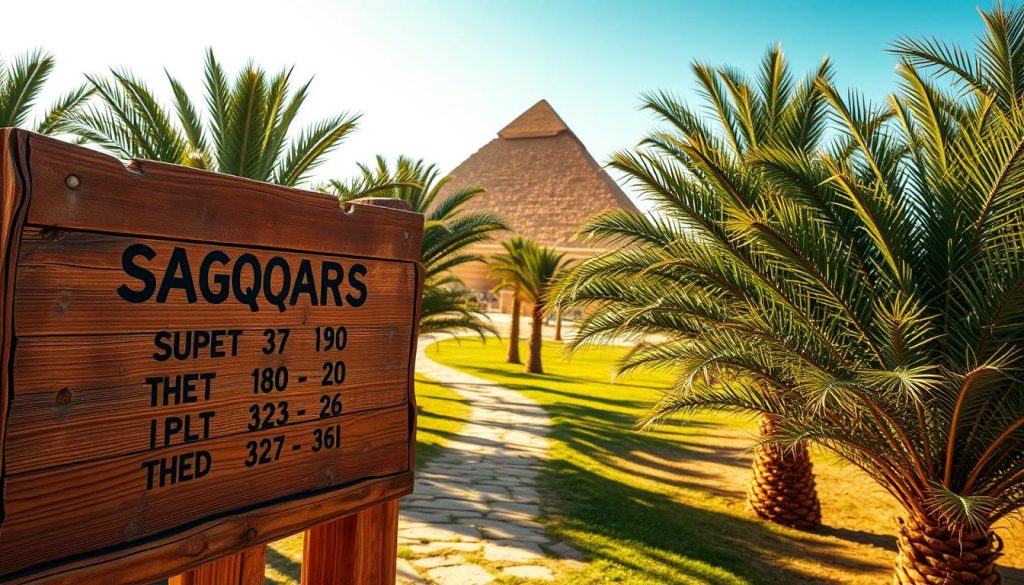
| Time | Advantages |
|---|---|
| Early Morning | Fewer crowds, cooler weather. |
| Late Afternoon | Quieter atmosphere, softer light for photos. |
| Midday | Best avoided due to heat and crowds. |
Understanding local life and climate conditions can also enhance your trip. Weekdays are generally less busy than weekends, and visiting during the cooler months (October to April) is ideal. This ensures you can explore at a leisurely pace without feeling rushed.
Here are a few practical tips to keep in mind:
- Bring water and wear comfortable shoes for walking.
- Use a guide or map to navigate the site efficiently.
- Plan your itinerary around the opening hours to maximize your time.
By following this guide, you’ll be able to enjoy a stress-free visit and fully immerse yourself in the rich history of this incredible site. Whether you’re marveling at ancient structures or uncovering hidden treasures, proper planning ensures an unforgettable experience.
Insights into the Imhotep Museum
Ever thought about how ancient builders shaped history with their hands? The Imhotep Museum offers a fascinating journey into the world of ancient construction and rituals. Located in the south of the site, this museum is a treasure trove of artifacts that bring the past to life.
Exhibits and Discoveries
Step inside, and you’ll find yourself surrounded by intricately carved stone relics. These exhibits highlight the advanced techniques used by ancient builders. From tools to ceremonial objects, every piece tells a story of innovation and craftsmanship.
One of the most striking displays is the collection of architectural models. These models showcase the evolution of construction methods, from simple structures to complex pyramids. It’s a testament to the ingenuity of ancient engineers.
The museum also features rare artifacts that reveal the spiritual side of ancient life. Items used in rituals and ceremonies offer a glimpse into the beliefs and practices of the time. These exhibits connect you with the artistry and spirituality of a bygone era.
Here’s what you can expect to see:
- Detailed stone carvings that showcase ancient artistry.
- Tools and models that highlight construction techniques.
- Ritual objects that provide insights into ancient beliefs.
Visiting the Imhotep Museum is more than just a tour—it’s a chance to connect with history. Each exhibit offers a unique perspective on the skills and creativity of ancient builders. Whether you’re a history enthusiast or a curious traveler, this museum is a must-see.
Experience Hidden Gems of Saqqara
Have you ever considered exploring the lesser-known corners of an ancient site? Beyond the iconic pyramids and grand tombs, there are hidden treasures waiting to be discovered. These off-the-beaten-path attractions offer a more intimate glimpse into the past, away from the crowds.
Off the Beaten Path Attractions
While the Step Pyramid and Serapeum draw most visitors, smaller tombs and chapels often go unnoticed. These quieter spots are rich in history and artistry. For example, the tomb of a lesser-known vizier reveals intricate carvings that tell stories of daily life and ancient rituals.
Another hidden gem is the sacred bull burial site, where you can explore the rituals surrounding the Apis bull. This area provides a deeper understanding of the spiritual practices of the time. These lesser-explored sites are perfect for those who want to save time and avoid the crowds.
Local Recommendations
Locals often have the best insights into unique experiences. They might guide you to a secluded chapel or a rarely visited tomb. These recommendations can help you make the most of your time and uncover the site’s hidden treasures.
One local favorite is the tomb of a high-ranking vizier, known for its stunning artwork and historical significance. Exploring these lesser-known spots allows you to connect with the timeless legacy of ancient builders and their contributions.
| Attraction | Highlights |
|---|---|
| Lesser-Known Tombs | Intricate carvings and historical insights. |
| Sacred Bull Burial Site | Rituals and spiritual practices of the past. |
| Local Favorites | Secluded chapels and rarely visited tombs. |
By exploring these hidden gems, you’ll gain a deeper appreciation for the artistry and ingenuity of ancient civilizations. Whether it’s the tomb of a vizier or the sacred bull burial site, these experiences will make your visit unforgettable.
Understanding Pyramid Construction Techniques
What if you could uncover the secrets behind the creation of ancient pyramids? These monumental structures were not just tombs but feats of engineering and artistry. From the ground up, every part of their construction reflects the ingenuity of ancient builders.
One of the most fascinating aspects is the use of materials. Limestone and granite were the primary choices, each selected for its durability and workability. The blocks were quarried, transported, and precisely fitted together, often with gaps as small as a hair’s width. This precision ensured the pyramids could withstand the test of time.
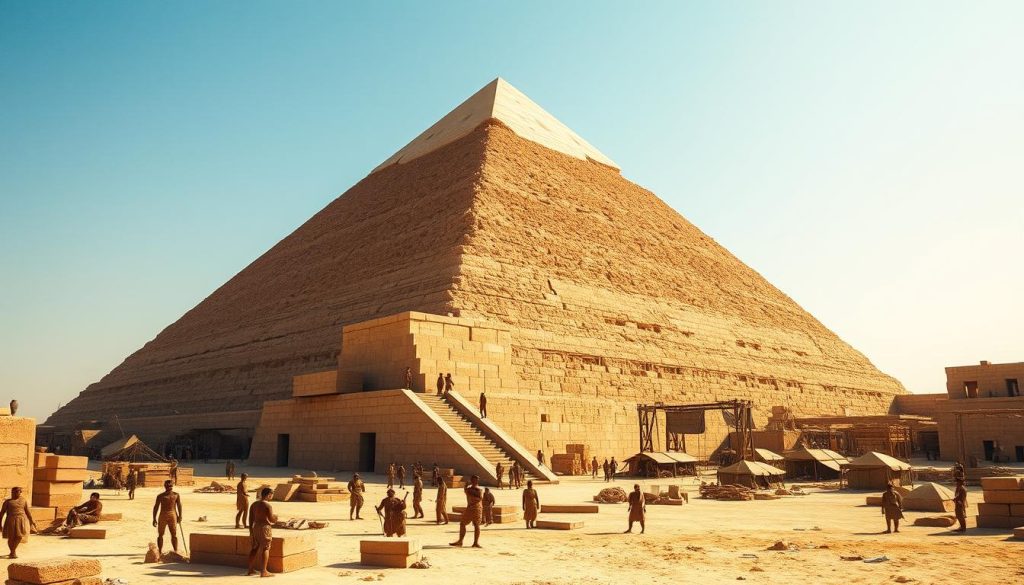
The construction process involved innovative techniques. Workers used ramps, levers, and even water to move massive stone blocks. The apis bull, a symbol of strength, inspired some of these methods, as its power was mirrored in the effort required to build these structures.
Artistry played a significant role too. Intricate paintings and carvings adorned the interiors, depicting scenes of daily life and religious rituals. These artworks were not just decorative but also served as a connection to the spiritual world.
Here’s a quick look at the key elements of pyramid construction:
- Materials: Limestone and granite were the primary building blocks.
- Techniques: Ramps, levers, and water were used to move stones.
- Artistry: Paintings and carvings added both beauty and meaning.
By understanding these techniques, you gain a deeper appreciation for the craftsmanship behind these enduring monuments. Each part of the pyramid tells a story of innovation and resourcefulness, making them more than just structures—they are timeless legacies.
Saqqara’s Link to Ancient Memphis and the Old Kingdom
Have you ever thought about the ties that bind ancient cities and their legacies? Saqqara, a site steeped in history, is deeply connected to the ancient capital of Memphis and the broader Old Kingdom era. This link reveals a fascinating story of cultural continuity and monumental achievements.
Memphis, once the heart of early dynasties, served as a home for pharaohs and their grand visions. Saqqara, its necropolis, became a place where these visions were immortalized. The massive saracophagi found here, some weighing several tons, stand as symbols of royal power and architectural ingenuity.
The tombs at Saqqara, including those of high-ranking officials, reflect the grandeur of the Old Kingdom. These structures were not just burial sites but also expressions of the era’s spiritual and cultural values. The intricate carvings and artifacts found within them tell stories of daily life, religious rituals, and the journey to the afterlife.
One of the most striking examples is the tomb of Mereruka, a vizier whose burial chamber is adorned with detailed reliefs. These artworks provide a window into the past, showcasing the artistry and beliefs of the time. Such discoveries highlight the enduring connection between Saqqara and Memphis.
Here’s a quick look at what makes this link so significant:
- Cultural Continuity: Saqqara and Memphis share a legacy of architectural and spiritual practices.
- Monumental Discoveries: The saracophagi and tombs reveal the grandeur of the Old Kingdom.
- Historical Narratives: The stories of pharaohs and their officials come alive through these sites.
By exploring Saqqara, you’re not just visiting a necropolis—you’re stepping into a home of history. Every stone, every carving, and every ton of limestone tells a story of a civilization that shaped the world. This connection to Memphis and the Old Kingdom is a testament to the enduring legacy of ancient builders and their monumental achievements.
Guided Tours & Local Expertise Benefits
Exploring ancient sites becomes richer with a local guide by your side. A knowledgeable expert can transform your visit into an immersive journey through history. From the Step Pyramid of Djoser to other treasures of the Old Kingdom, a guide brings these wonders to life with personal anecdotes and insider knowledge.
Why a Local Guide Makes a Difference
Local guides offer more than just facts. They provide context, helping you understand the significance of each site. For example, the Step Pyramid isn’t just a structure—it’s a testament to ancient innovation. Guides can explain its construction, its role in history, and even share stories about the people who built it.
Language and cultural barriers can be challenging when traveling. A guide helps bridge these gaps, ensuring you don’t miss out on important details. They can also navigate the site efficiently, saving you time and effort.
Here’s how a guided tour enhances your experience:
| Benefit | Details |
|---|---|
| Historical Insights | Learn about the Old Kingdom and its architectural marvels. |
| Personalized Attention | Get answers to your questions and tailored explanations. |
| Efficient Navigation | Explore key attractions like the Step Pyramid of Djoser without getting lost. |
To make the most of your visit, consider hiring a private guide. They often include additional perks like transportation, lunch, and even optional activities. This ensures a seamless and enriching experience.
By choosing a guided tour, you’re not just visiting a site—you’re connecting with its history. Whether it’s the grandeur of the Step Pyramid or the mysteries of the Old Kingdom, a guide helps you uncover the stories behind the stones.
Essential Practical Tips for Your Trip
Ready to make your trip seamless and comfortable? Proper preparation ensures you can fully enjoy your adventure. From clothing to gear, here’s what you need to know before you go.
What to Pack and Wear
Exploring ancient sites requires the right attire. Start with comfortable footwear. The terrain can be uneven, so sturdy shoes are a must. Pair them with lightweight, breathable clothing to stay cool in the desert climate.
Don’t forget sun protection. A wide-brimmed hat, sunglasses, and sunscreen are essential. A reusable water bottle is also a smart addition to stay hydrated throughout the day.
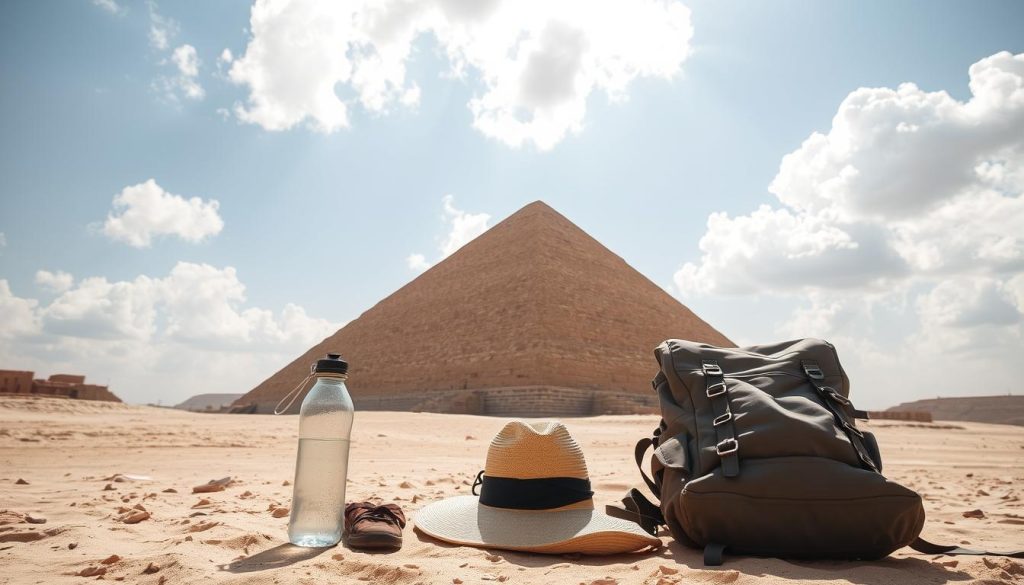
- Footwear: Sturdy, comfortable shoes for walking.
- Clothing: Lightweight and breathable layers.
- Sun Protection: Hat, sunglasses, and sunscreen.
- Hydration: Reusable water bottle.
Must-See Sites on Your Tour
Your visit wouldn’t be complete without exploring the pyramid unas and pyramid teti. These iconic structures offer a glimpse into the architectural brilliance of the past. Plan your route in advance to make the most of your time.
Here’s why these sites are worth the visit:
- Pyramid Unas: Known for its intricate carvings and historical significance.
- Pyramid Teti: A testament to ancient engineering and artistry.
By packing smart and planning ahead, you’ll ensure a smooth and enjoyable tour. Whether you’re marveling at the pyramid unas or exploring the pyramid teti, these tips will help you make the most of your adventure.
Conclusion
Ready to uncover the magic of an ancient world? This historic site offers a blend of monumental pyramids, hidden tombs, and timeless stories that make it a must-visit attraction. From the grandeur of the Step Pyramid to the intricate carvings in lesser-known tombs, every corner holds a piece of history waiting to be discovered.
Planning your day trip here ensures you’ll experience the best of what this site has to offer. With its rich history and unique charm, it’s a destination that promises both adventure and insight. Whether you’re marveling at ancient architecture or exploring hidden gems, your journey will be unforgettable.
Equip yourself with the tips and insights from this guide, and embark on your own exploration. The past is waiting to be uncovered—start planning your adventure today!
The above is subject to change.
Check back often to TRAVEL.COM for the latest travel tips and deals.
Here are some Tours & Sightseeing suggestions that might pique your interests!
